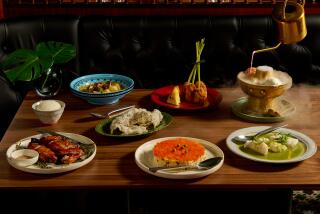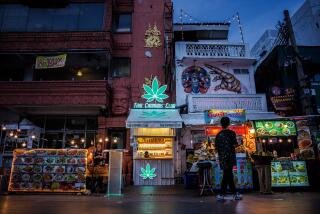Shopping the Golden Triangle
A receptionist at the Anantara Resort and Spa Golden Triangle suggested the idea of shopping in three countries in a single day.
“Thailand, Laos and Myanmar — all three countries without a flight or train ride?” I again asked Watcharee Srithai at the reception desk.
It certainly appealed to me, doing something unusual and, I hoped, not exhausting here in the Golden Triangle, where Thailand, Myanmar (formerly Burma) and Laos converge.
“Yes, no planes, no trains. And it’s easy,” she said, reassuring me for a second time and explaining the details of how, where and when.
Laos
I set off on a five-minute taxi ride to Sop Ruak, a Thai village on the Mekong River. The driver dropped me at a kiosk, where I hired a boat to take me across the river to Don Sao Island in Laos, which has a village that trades with tourists. The round-trip ride would cost $3 an hour, the ticket seller said, and the boatman would wait while I shopped.My boatman pointed out Myanmar on the left and Laos across the Mekong as he led the way down concrete steps to the wide, brown river coursing below the steep, slanting bank. We climbed into a long-tail boat, common in Southeast Asia, and with a swish and a spray, skimmed southeast.
We passed a couple of long-tailed boats, one with a woman wearing a conical palm-frond hat. Tall kapok trees lined the Laotian bank, which had looked largely uninhabited.
The previous week, I had completed a monthlong tour of Vietnam, Cambodia and Laos with an adventure travel company and had enjoyed several trips on different stretches of the historical and mythical Mekong, which originates in Tibet, runs south through China, borders Myanmar, Thailand and Laos and then flows through Cambodia and Vietnam until it joins the South China Sea.
The Lao People’s Democratic Republic, centuries ago the “Kingdom of One Million Elephants,” is today one of Asia’s most unchanged and least-visited countries. Despite U.S. military offensives in the region during the 1960s and 1970s, Laotians warmly welcome Americans. Nowadays, the country’s market economy is picking up, but it’s not yet on the fast track of Asia’s capitalism.
Within 10 minutes, we reached the shore. I climbed the steps, stitched in places by wood and bamboo supports, up the steep clay bank. Three bored-looking uniformed Laotian men lounged in a bamboo kiosk. After a cursory glance at my passport, they accepted the permit fee of 20 Thai bahts (50 cents) and stamped a receipt.
Twenty yards away, two large souvenir stalls, built of wood and bamboo with straw roofs, overflowed with items for sale. Although about a dozen stalls lined dirt roads, I headed for the nearest vendor, eager to see what was offered.
Colorful scarves, shirts, trousers and sarongs (the customary waist-to-ankle skirts worn by Laotian women) hung from walls and ceilings and lay neatly folded on tables. The Laotian women, master weavers of complex, intricate geometric patterns handmade on looms, traditionally produce silk scarves and shawls. In the previous weeks, I’d bought more than my fair share of these fabrics, and they were again irresistible. I bought two scarves, one in shades of green and the other in blues highlighted with gold thread, for $5 each.
Throughout Laos, I found no prices affixed to items in the street stalls and markets, and here was no exception. Buyers are expected to bargain, first requesting the price, although vendors usually ask for double what they will eventually accept. Although every Asian country has its own currency — kyat in Myanmar, kips in Laos and bahts in Thailand — street stalls, markets and shops gladly accepted U.S. dollars. Shops also took credit cards, and their scarves and shawls were tagged at $20 to $40 and higher.
On a wall of the Don Sao stall, wide-legged, shiny black silk fisherman-style pants shimmered at me. Unable to resist, I bargained them down to $8 from $10. Next, my eye caught another similar pair of pants, dark blue cotton patterned with gold elephants. Wild and certainly not high style, but I liked them. Five bucks.
Outside on the street, I scoured tables laden with rows of attractive handicrafts: small ceramic bowls with flower patterns, boxes with mother-of-pearl inlay and compasses hidden in tiny round containers made of bone and incised with scenes. I chose one with a tiny fisherman reeling in a gigantic fish. More tables held all sorts of souvenirs, including Buddha and elephant statues of various shapes and sizes in wood and metal.
Then I came upon rows of bottled snakes. Whiskey-pickled snakes glared malevolently through the yellowish fluid, $3 apiece. Some looked like cobras. Some looked astonished. Some looked hypnotic. I asked the saleswoman why people drink this stuff. “For headache, for fever, for make good love,” she said.
“Not necessary for me today, thank you,” I said, and also passed on giant-sized bottles of “Wine Lao” and whiskey. After 40 minutes, satisfied with my purchases, I returned to Thailand and paid for the hour’s trip.
Myanmar
Back at the Anantara, I reserved a taxi to Mae Sai, the Thai-Myanmar border town next on my shopping itinerary. On my way to lunch, I was stopped by John Roberts, the blond, lanky Englishman who runs the resort’s Elephant Camp, which had drawn me to this corner of Southeast Asia. At the camp, hotel guests can tend elephants and learn to ride elephants.The Anantara Resort & Spa Golden Triangle is in Chiang Saen, on a ridge a mere half-kilometer (about a third of a mile) from where the three countries meet. From the hotel, I could gaze over the tall native elephant grass to the jungles of Myanmar and Laos beyond.
John said he planned to inspect the market in the town of Thakilek in Myanmar, bordering Mae Sai, Thailand, and invited me to meet him later that afternoon at the border crossing.
After a lunch of grilled salmon spiced with lemongrass, kaffir lime leaves, garlic, ginger, chiles and cilantro in Anantara’s dining room, I took the half-hour, 17-mile taxi ride to Mae Sai.
The bustling border town once was a conduit for smuggled goods from Laos and Myanmar, but it now offers legitimate shopping opportunities. The taxi dropped me at the immigration office (next to the hospital) so I could arrange a free visa to leave Thailand, then to the border building, where I met John. We relinquished our passports and paid 250 bahts (about $6) each for a permit to enter Myanmar. We walked the 90 yards across the bridge spanning the Mae Sai River into Myanmar.
In my mind and heart, Myanmar will always be Burma, an enchanting country lost in the shadows of isolation and still under American sanctions because of the ruling junta’s repressive policies. I’ve loved Burma since my first trip in the early 1980s, and I was happy to be back, if only briefly.
On the other side of the bridge, wide concrete steps led down into Thakilek’s streets: a confusion of shops, pedestrians and bikes weaving by stucco buildings. John and I meandered in and out of shops that sold bootlegged music cassettes and movie videos and DVDs.
We peeked into stores selling blankets, fabric, clothing, kitchen utensils and bamboo items. I stopped to admire Burmese lacquerware bowls, plates and boxes; the beauty of this folk art has an ageless appeal to me.
Other shops contained all sorts of food, in neat piles. One had an amazing assortment of dried fish that gave off a pungent odor, which mingled with the appetizing aroma of fresh garlic coming from the rear of another store. I saw large plastic bags containing a spongy white material that looked like dried tripe, but John said it was the center of bamboo, an easily obtained carbohydrate used in soup.
On the front counter of a jewelry-souvenir shop, amber and jade pendants hung on stands. “Amphan, amphan,” the vendor said, pointing to the amber, a beautiful stone believed to invite health, wealth and prosperity.
“Yes, amber with many flaws,” I said, peering closely at the piece. It had beautifully shaped black, fossilized leaves embedded in it. This piece, on a silver hoop, intrigued me, and it was far cheaper than the clear stones priced at $10 and $20.
“Lucky money! Lucky money!” the woman sang, happily waving the $5 we had agreed on.
At a similar store, I bought a tiny jade Buddha for $3, a silver dolphin charm for the same price, and three small metal Buddhas for a couple of dollars more.
John and I headed for the shop he wanted to check out. It displayed hunting and fishing items, mostly binoculars, knives and animal trophies.
“All cheap Chinese gear,” John whispered so the shop’s owner would not hear. “That’s a clouded leopard skin and there’s a wild boar’s skull, a macaque monkey, and bones and antlers of many deer. Also, one elephant tooth and a python skin. No tiger bones or skins, no rhino horns. This stuff has been here for months. Thankfully, nothing is in demand.”
Picking up a skull, he turned it over in his palm. “There’s nothing new here — just a couple of deer skulls and some fake tiger penises.”
“Are they phony trophies?” I asked.
John just smiled and did not answer.
After visiting a similar store on another street, we speedily retraced our steps to Mae Sai. Afterward, I noticed, “walk” was noted as the mode of transport on my passport’s Thai stamp.
Thailand
Thailand has always given me a feeling of bounty and security. I think it quite remarkable that for 800 years this land — rich in cultural heritage, resources and beauty — has never been conquered or colonized.Thailand is an exciting place to shop because of the good quality and diverse selection. We strolled four blocks, passing shops stockpiled with Asian souvenirs. The scent of lemongrass and ginger came from somewhere and smelled so good that it made John hungry. He wandered off to eat sausages while I entered Mandalay, an elegant, spacious boutique opposite a police station.
The saleswomen met me with smiles, murmuring the greeting, “Sawasdee kha.” Mandalay’s jewelry, clothing, fabrics, handbags and souvenirs were stylish and top quality. Its gem section intimidated me with its dazzling rubies, sapphires, emeralds and gold, so I browsed through the costume jewelry and chose a necklace, a jade ball suspended on a silver thread, for $8. Another jade necklace held a silver fish, from which swung strands holding silver shells, turtles and a fish. So tempting. I got it for $100.
The boutique’s fashionable embroidered-silk evening jackets were priced from $90 to $300. Instead, my gaze latched on racks of sarong fabric, in particular a swath of silk with greens merging into yellow ochre, with painted figures running after a hoop in a border along the hem.
Flushed with acquisitiveness, I forgot to ask how much it cost, and blithely charged all three purchases on my credit card.
In a state of euphoria, my three-country shopping spree was complete for the day.
*
(BEGIN TEXT OF INFOBOX)
GETTING THERE:
From LAX, Thai Airways offers connecting service (change of planes) to Chiang Rai. Restricted round-trip fares begin at $810.
TELEPHONES:
To call the number below from the U.S., dial 011 (the international dialing code), 66 (country code for Thailand) and the local number.
WHERE TO STAY:
Anantara Resort & Spa Golden Triangle, 229 Moo 1, T. Wiang, Chiang Saen, Chiang Rai; 53-78-4084 https://www.anantara.com . The resort, 40 miles north of Chiang Rai, opened in October. I stayed at the resort because I was curious about its Elephant Camp, where guests can feed and bathe its four elephants and learn mahout skills. The resort has 160 acres, with a lake, a river and an indigenous forest for such activities as mountain biking, nature walks and bird-watching. I paid the introductory rate of $199 for two nights; the same package now is available for $256, additional nights are $99. Doubles range from $128 to $190.
TO LEARN MORE:
Tourism Authority of Thailand, (323) 461-9814, https://www.tourismthailand.org .
— Patricia Woeber
More to Read
Sign up for The Wild
We’ll help you find the best places to hike, bike and run, as well as the perfect silent spots for meditation and yoga.
You may occasionally receive promotional content from the Los Angeles Times.






